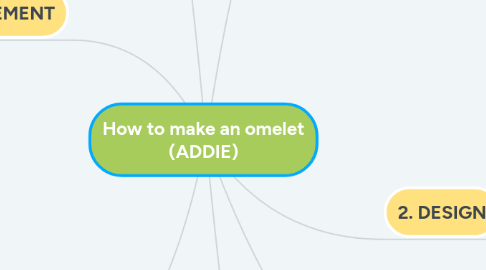
1. DESCRIPTION. Design is a systematic process of specifying learning objectives. Detailed storyboards and prototypes are often made, and the look and feel, graphic design, user-interface and content are determined here.
2. 1. ANALYZE
2.1. RESULT. This phase should result in a needs analysis and a training plan
2.2. DESCRIPTION. During analysis, the designer identifies the learning problem, the goals and objectives, the audience’s needs, existing knowledge and any other relevant characteristics. Analysis also considers the learning environment, any constraints, the delivery options, and the timeline for the project.
2.3. Step 1.1 LEARNERS. Identify who are the learners and what are their characteristics and existing knowledge
2.3.1. my 1.1 - Learners are young adults, tech savvy, on a low budget & inexperienced cooks
2.4. Step 1.2. TARGET BEHAVIOR. Establish what is the desired new behavior
2.4.1. my 1.2 - Target behavior is to be able to make a tasty omelet
2.5. Step 1.3 CONSTRAINTS. Determine types of learning constraints
2.5.1. my 1.3 - Constraints are to have a short course, with easy steps, few and cheap ingredients
2.6. Step 1.4 DELIVERY OPTIONS. Identify delivery options
2.6.1. my 1.4 - Delivery options are mostly or fully online
2.7. Step 1.5. TIMELINE. Identify timeline for project completion.
2.7.1. my 1.5 - Timeline for completion is by Feb 7-11, 2020
3. 2. DESIGN
3.1. Step 2.1 TOPICS. Determine topics to be covered and time to be spent on each
3.1.1. my 2.1 - Topics are: 1) Warmer/Introduction, 2 minutes; 2) Pre-teach ingredients list, 2 min.; 3) Preview of cooking steps, 3 min.; 4) Execute steps in detail, 10 min.; 5) Follow-up evaluation activity, 3 min.
3.2. Step 2.2 ACTIVITIES. Identify learning activities and exercises to be used. Can use storyboards or prototypes.
3.2.1. my 2.2 - Learners will listen, answer questions, observe and execute the recipe alongside the instructional video and evaluate their cooking results.
3.3. Step 2.3 ASSESSMENT. Identify assessment instruments
3.3.1. my 2.3 - For assessment learners will submit a photo of their omelet and a self-assessment based on specified criteria.
3.4. Step 2.4 MEDIA. Select media
3.4.1. my 2.4 - Media will be an online instructional video with exchange of questions and responses in Comment section at bottom of video and in downloadable handouts. Provide online way for learners to upload their results.
3.5. RESULT. An overview of the course design and storyboards / prototypes.
4. 3. DEVELOP
4.1. Step 3.1 PREPARE draft materials and activities
4.1.1. my 3.1 - Prepare ingredients (3 eggs, salt, pepper, etc.), materials (pan, bowl, whisk, etc.), and activities ( questions to ask, etc.).
4.2. Step 3.2 TRY OUT materials and activities with target audience members
4.2.1. my 3.2 - Try executing the lesson with a small number of learners and obtain their feedback.
4.3. Step 3.3 REVISE, refine and produce materials and activities
4.3.1. my 3.3 - Based in feedback, make revisions to lesson and recipe as needed. Upload the instructional video on a sharing platform such as YouTube. Prepare the written questions and handouts, then upload them.
4.4. DESCRIPTION. The actual creation(production) of the content and learning materials based on the Design.
4.5. RESULT. This phase should result in the course content.
5. 4. IMPLEMENT
5.1. Step 4.1 DELIVER training
5.1.1. my 4.1 - Set up a schedule and deliver training to actual learners.
5.2. Step 4.2 HELP. Provide help or support as needed
5.2.1. my 4.2 - Answer comments and questions at the bottom of the video.
5.3. RESULT. With this phase, the course is on the LMS and learner’s can start and complete the course.
5.4. DESCRIPTION. During implementation, the plan is put into action and a procedure for training the learner and teacher is developed. Materials are delivered or distributed to the student group. After delivery, the effectiveness of the training materials can be evaluated.
6. 5. EVALUATE
6.1. DESCRIPTION. This phase consists of 1. formative and 2. summative evaluation. Formative evaluation is present in each stage of the ADDIE process. Summative evaluation consists of ways of obtaining feedback from the users. Revisions are made as necessary.
6.2. RESULT. An evaluation report and actionable changes for the current or future courses.
6.3. Step 5.1. FEEDBACK. Obtain feedback and document it.
6.3.1. my 5.1 - Obtain feedback from Comment section below the video or through uploads.
6.4. Step 5.2. CHANGES. Identify actionable changes and revise course as needed.
6.4.1. my 5.2 - Identify which proposed changes should be made and implement them.
